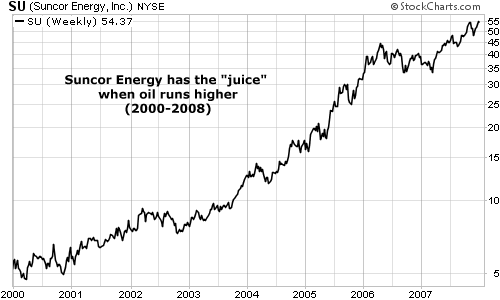| Home | About Us | Resources | Archive | Free Reports | Market Window |
A Realistic Shot at Making 200% in the Canadian Oil SandsBy
Saturday, October 24, 2009
Despite what most people believe, investing in oil is actually simple, easy, and capable of building a lifetime of wealth.
All you need is this four-step plan: 1) Buy an established, well-run oil producer like ExxonMobil (NYSE:XOM) or ConocoPhillips (NYSE:COP). 2) Hold it for years and collect dividends. 3) Always reinvest those dividends. 4) Get rich. ExxonMobil, ConocoPhillips, and companies like them are masters at finding oil, producing it at a low cost, and refining it into useful products. And as Tom Dyson pointed out a couple years back, a boring, well-run oil company is an extraordinary long-term wealth generator. Standard Oil, for instance, generated a 14.42% annual return for over 50 years. But if you're looking to trade in oil, I suggest you find a much different company than ExxonMobil... one that finds oil and produces it at a high cost. As I've mentioned in these pages before, if you want to profit from a bull run in oil, you need to know about the potential of owning high-cost oil producers. You need to know about the potential of the Canadian oil sands. This region could make you a fortune in the coming years. It all comes down to leverage... In conventional oil regions like Saudi Arabia or West Texas, oceans of oil sit thousands of feet underground. Tapping that oil is a lot like sticking a straw in the ground and sucking it out. Oil companies in these regions make money whether oil is at $30 or $75. The Canadian oil sands are a different story. This region in Western Canada is one of the world's largest oil resources. It holds an estimated 170 billion barrels of oil... but it's trapped in layers of silt and sand. Oil-sands companies have to buy huge excavators to dig up the silt. They have to buy the world's biggest dump trucks to haul it (just one tire on these things can cost $60,000). They have to build giant facilities to "wring" the petroleum out of it. And they have to pay a highly trained, highly skilled workforce to make it all happen... all out in the middle of the Canadian wilderness. The high cost structure means thin profit margins. Margins are so tight in the oil sands that if oil falls below $35 a barrel for any length of time, the industry gets wiped out. But when oil prices rise, profits in the Canadian oil sands soar. This means big leverage for investors. To get an idea of the explosive potential here, let me show you an example... Let's say oil is at $40 per barrel. We have two oil producers, ABC and XYZ. ABC is an efficient, low-cost oil producer. Its production costs are $20 per barrel... so it makes $20 of profit on every barrel it sells. XYZ is an inefficient, high-cost oil producer. Its production costs are $35 per barrel... so it makes $5 of profit on every barrel it sells. If oil rises to $70, ABC's profit rises to $50 per barrel... an increase of 150%. Poor old inefficient XYZ, however, sees its profit per barrel increase to $35 – a 600% increase! XYZ stock will rise much more than ABC to reflect the margin explosion. When you look at the numbers during a big run-up in oil prices, the returns get ridiculous. If oil climbs to $120 in the scenario above, high-cost XYZ sees an incredible 1,600% increase in margins... which can cause the stock to rise just as much. Of course, this leverage works the same way in reverse. A large decline in oil can wipe out a high-cost producer in a hurry. But right now, oil's breakout above $75 means the market is in "bull mode." It means the trend is up... so any good trend trader should be long. Most folks should stick to larger oil sands names like the blue-chip Suncor or Canadian Oil Sands Trust. There's even a tiny, inventive ETF from Claymore that focuses exclusively on the oil sands (it trades on the Toronto exchange under the symbol CLO). Advanced traders are best served with smaller, more speculative companies. These are the ones capable of the 1,600% rise I mentioned. Dyson and I just recommended two tiny oil sands plays to readers of our Penny Trends advisory. If oil continues its rise, these companies have incredible potential. Good investing, Brian Hunt P.S. Both of these two companies are "buys" right now. If you'd like to access our report immediately, consider a trial subscription to Penny Trends. You can learn more here. P.P.S. If you're looking for a knowledgeable broker who knows the oil sands region inside and out, contact Eric Angeli or Rick Rule at Global Resource Investments (800-477-7853). There's going to be a lot of money made in this region over the coming years, and these guys can help guide you to it.
Further Reading:
America's Huge New Source of Oil Market NotesA PICTURE OF HIGH-COST LEVERAGE
|
In The Daily Crux
Recent Articles
|


